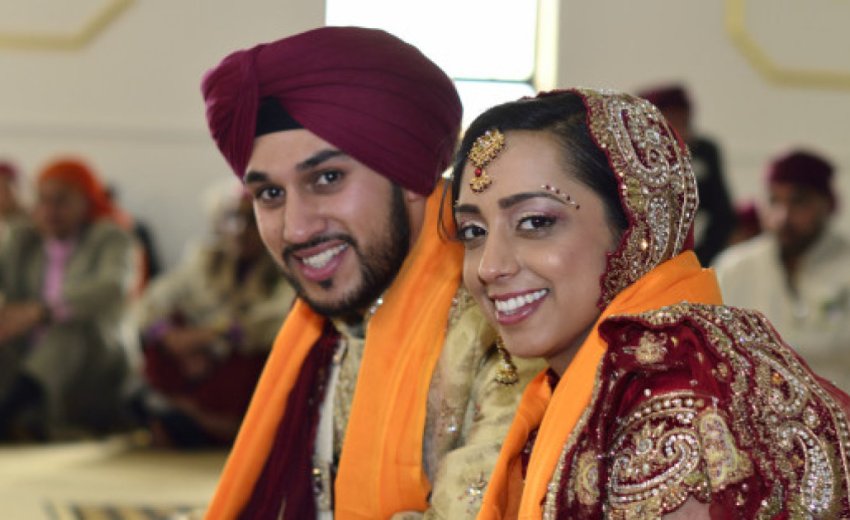The Sikh marriage ceremony, known as Anand Karaj, was first introduced by Guru Amar Das Ji and means "Act towards happiness" or "Act towards happy existence." The core of the Anand Karaj is the 'lavan', wherein hymns are sung with the bride and groom circumambulating the Guru Granth Sahib. The Anand Karaj is one of the most sacred ways of tying the knot, a long-lasting tradition practiced by all Sikhs. In addition to setting the marriage within the perspective of God's unity, the ceremony serves to establish the fundamental guidelines for a happy marriage.
An overview of the Anand Karaj Marriage Act
The Delhi government finally met the 109-year-old demand of the Sikhs. Sikhs had to register their marriages under the Hindu Marriage Act 1955. The Anand Marriage Act for Sikhs had been initiated during the British Era in 1909 but had not been implemented till 2012. Many Sikhs were profoundly concerned by this, especially those who had emigrated abroad because although identifying as Sikhs, their marriages had been registered as "Hindu."
The only way to end this dissonance and keep the community from falling under the "Hindu" umbrella was to pass an exclusive marriage act for the community. Furthermore, a lot of Sikhs felt that the Hindu Marriage Act's inclusion of religious minorities like Sikhs and Jains violated the secular character of the Constitution of India.
The Anand Marriage (Amendment) Bill was passed by India's parliament in 2012, allowing Sikhs to register their marriages under the Anand Karaj Marriage Act rather than the Hindu Marriage Act. President Pratibha Devi Singh Patil gave her assent to the bill, which was passed on June 7, 2012, during the budget session.
When did the Supreme Court of India make marriage registration compulsory?
Sikhs were required to register their marriage under the Hindu Marriage Act after the Supreme Court of India declared such registration obligatory. Sikhs made every effort they possibly could to get an amendment in an already existing Act called Anand marriage Act, 1909. The Sikh Marriage Act was passed by the Britsh Council and for the first time Sikh marriage was recognized through “Anand” which is also popularly known as “Anand Karaj”. The act amendment was made in 2012 by the Central Government, keeping a provision for registration of marriages performed by Sikhs through Anand or Anand Karaj.
Registration of Sikh marriages under this New Amended Act
Following the amendment by the Central Government, the states were supposed to set their own rules for facilitating Anand marriage registration of Sikhs. Through RTIs, it has been revealed that only a few states have framed the rules so far. The Sikhs are being forced by the situation to register their marriages under the "Hindu Marriage Act" rather than the "Anand Marriage Act."
The religions and cultures of India are diverse. As a result, it becomes necessary for the laws to meet the desires of its citizens so that they can practice, profess, and spread their religion free from conflict with others. In this way, the framers of the constitution could fully realize their vision of a secular, democratic, and socialist nation
The constitution of India which first invalidated the Anand Marriage Act 1909 has failed to even consider the amendment into the constitution which was adopted in 1950. As a result of this Act, Sikhs are considered Hindus and are required to follow all Hindu laws. Despite the Anand Marriage Act being passed in 1909, marriages were still registered under the Hindu Marriage Act.
The Anand Marriage Amendment Bill 2012 was passed by the Indian Parliament
In 2012, both houses of the Indian Parliament passed the Anand Marriage Amendment Bill 2012. Sikh traditional marriages were legalized by amending the Anand Marriage Act of 1909, thereby allowing them to be registered. Those couples who have registered their marriages under the amended Anand Marriage Bill will not have to register their marriages under any other law.
The Anand Marriage Act allows Sikhs to register their marriages
Under the Anand Marriage Act, Sikhs can now register their marriages. All working hours are open for the parties to the marriage to examine the records in the Marriage Register. There must be a complete application form signed by both parties, as well as documentary evidence of both parties' dates of birth and an affidavit stating the time, date, and location of the marriage.
You can review the Anand Karaj Marriage Act by clicking on this link https://legislative.gov.in/sites/default/files/A1909-07.pdf.

